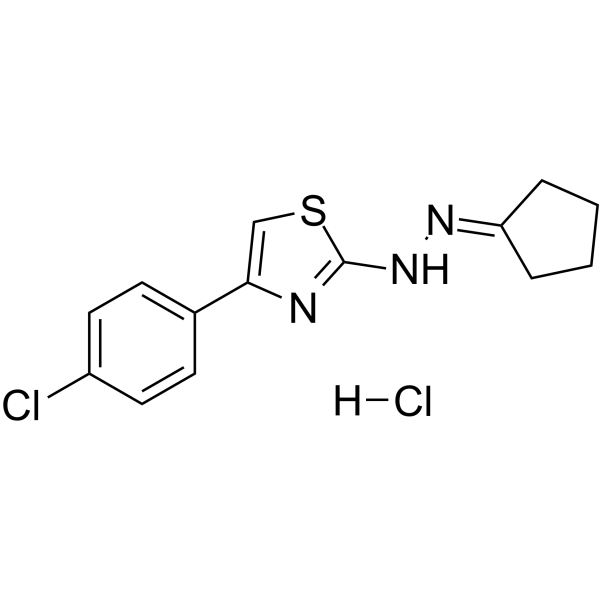2108899-91-6
| Name | CPTH2 (hydrochloride) |
|---|---|
| Synonyms |
4-(4-Chlorophenyl)-2-(2-cyclopentylidenehydrazino)-1,3-thiazole hydrochloride (1:1)
Cyclopentanone, 2-[4-(4-chlorophenyl)-2-thiazolyl]hydrazone, hydrochloride (1:1) CPTH2 (hydrochloride) |
| Description | CPTH2 hydrochloride is a potent histone acetyltransferase (HAT) inhibitor. CPTH2 hydrochloride selectively inhibits the acetylation of histone H3 by Gcn5. CPTH2 hydrochloride induces apoptosis and decreases the invasiveness of a clear cell renal carcinoma (ccRCC) cell line through the inhibition of acetyltransferase p300 (KAT3B)[1][2]. |
|---|---|
| Related Catalog | |
| Target |
GCN5 p300 |
| In Vitro | CPTH2 (100 μM; 12, 24, 48 hours) hydrochloride causes a decrease in cell proliferation after as early as 12 h with a further significant reduction after 48 h stimulation[1]. CPTH2 (100 μM; 12 or 48 hours) hydrochloride causes a comparable drop of the activity in both cell lines[1]. CPTH2 (100 μM; 48 hours) hydrochloride produces a drastic increase in apoptotic/dead cell population after 48 h[1]. CPTH2 (100 μM; 12, 24, 48 hours) hydrochloride shows a reduced acetylation of both global AcH3 histone and H3AcK18[1]. CPTH2 (100 μM; 24, 48 hours) hydrochloride is capable to counteract invasion and migration of ccRCC-786-O cells in culture[1]. CPTH2 (0.2, 0.5, 1 mM) hydrochloride inhibits the growth of a GCN5 deleted strain and a single catalytic mutant E173H[2]. CPTH2 (0.6, 0.8 mM; for 24 hours) hydrochloride inhibits histone H3 acetylation in yeast cell cultures[2]. CPTH2 hydrochloride inhibits the Gcn5p dependent functional network[2]. Cell Proliferation Assay[1] Cell Line: Papillary thyroid (K1) and clear cell Renal Cell Carcinoma (ccRCC-786-O) cell lines Concentration: 100 μM Incubation Time: 12, 24, 48 hours Result: Caused a decrease in cell proliferation after as early as 12 h with a further significant reduction after 48 h stimulation. Cell Viability Assay[1] Cell Line: K1 and ccRCC-786-O cell lines Concentration: 100 μM Incubation Time: 24 hours (K1 cell) and 48 hours (ccRCC-786-O cell) Result: Caused a comparable drop of the activity in both cell lines. Apoptosis Analysis[1] Cell Line: ccRCC-786-O cells Concentration: 100 μM Incubation Time: 48 hours Result: Produced a drastic increase in apoptotic/dead cell population after 48 h. Western Blot Analysis[1] Cell Line: ccRCC-786-O cells Concentration: 100 μM Incubation Time: 12, 24, 48 hours Result: Showed a reduced acetylation of both global AcH3 histone and H3AcK18. |
| References |
| Molecular Formula | C14H15Cl2N3S |
|---|---|
| Molecular Weight | 328.260 |
| Exact Mass | 327.036377 |
| Hazard Codes | Xi |
|---|
